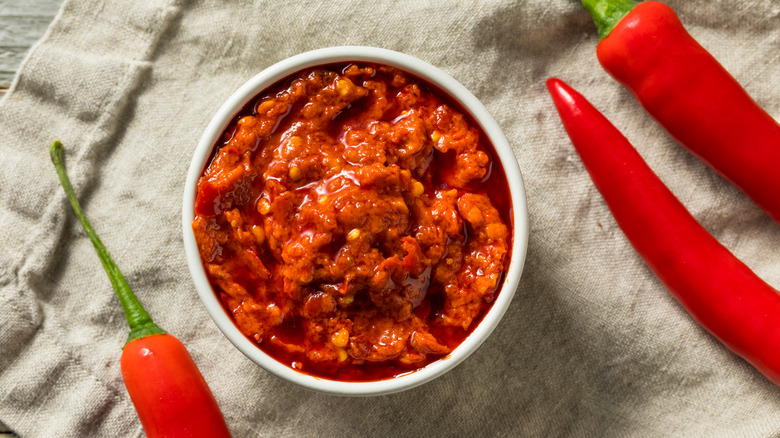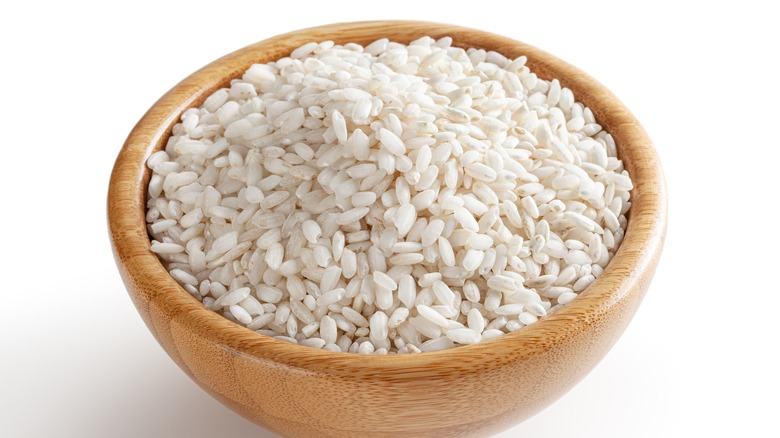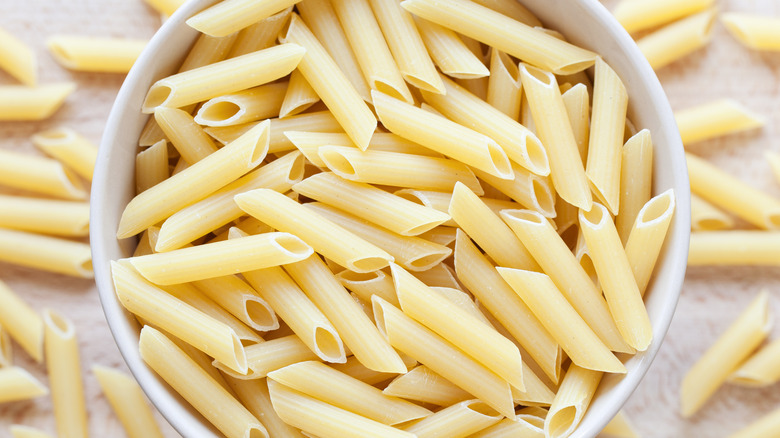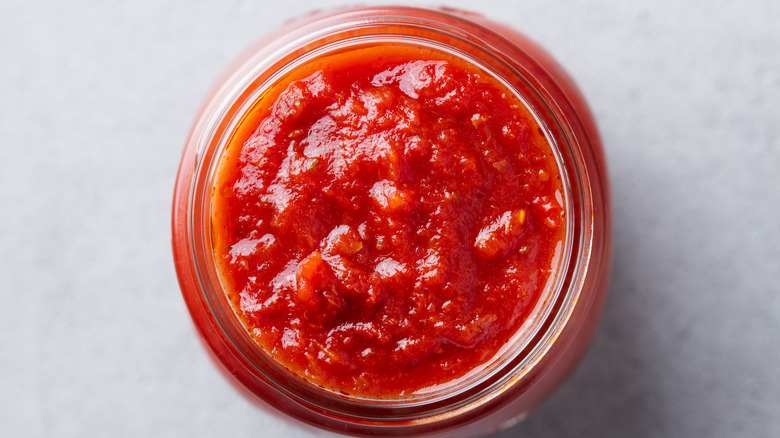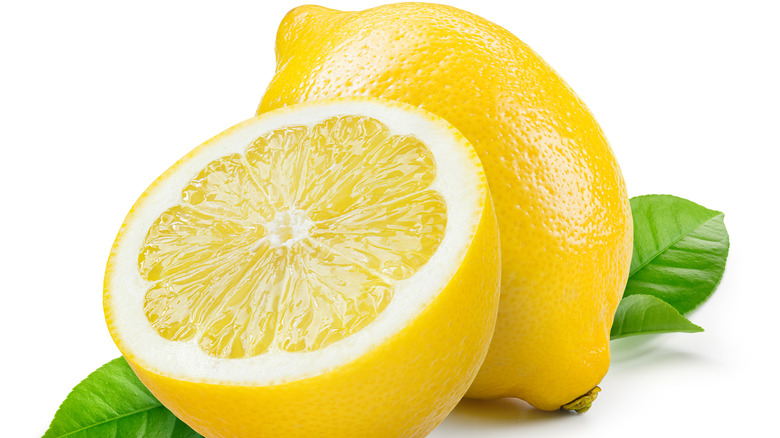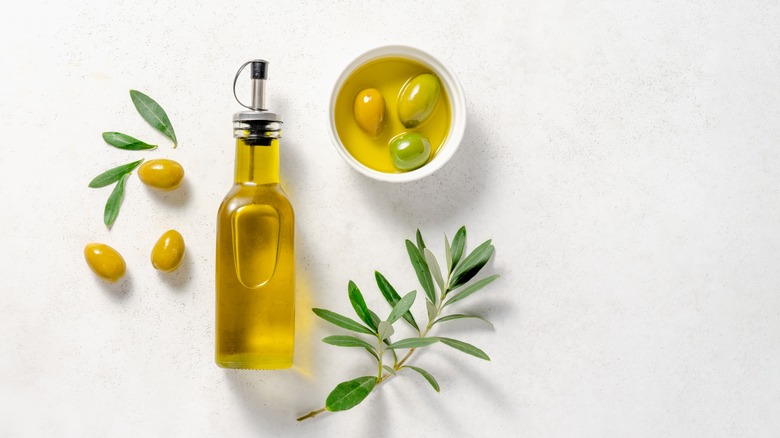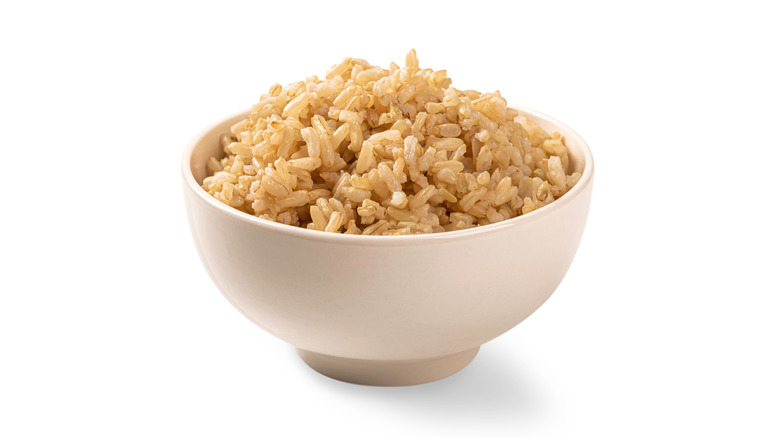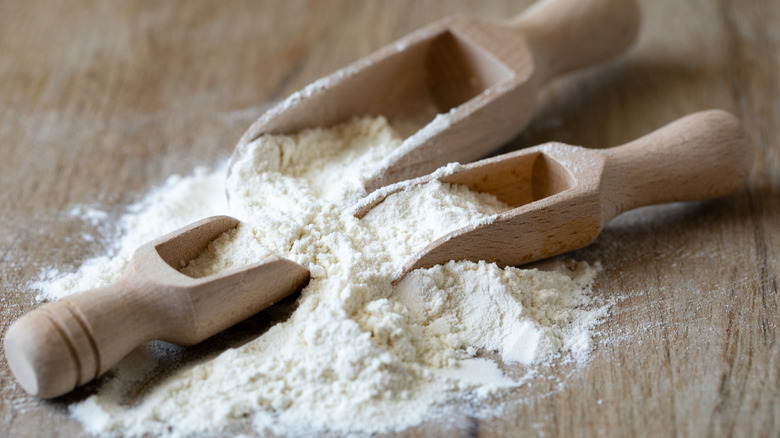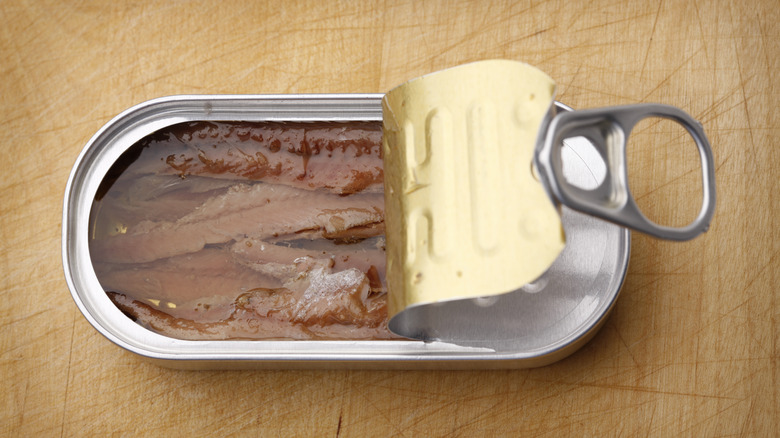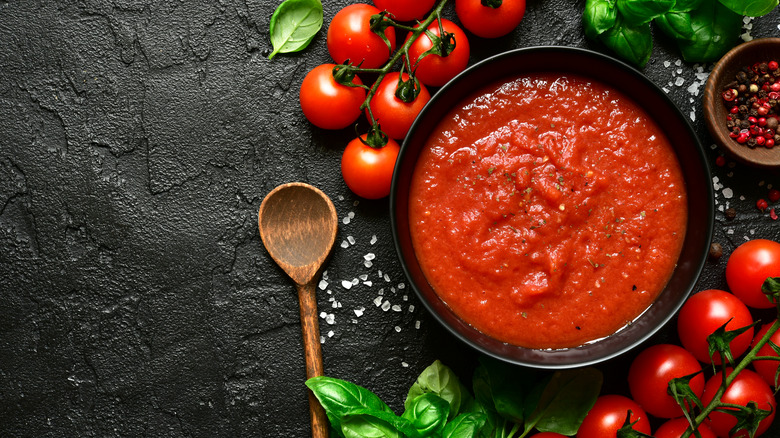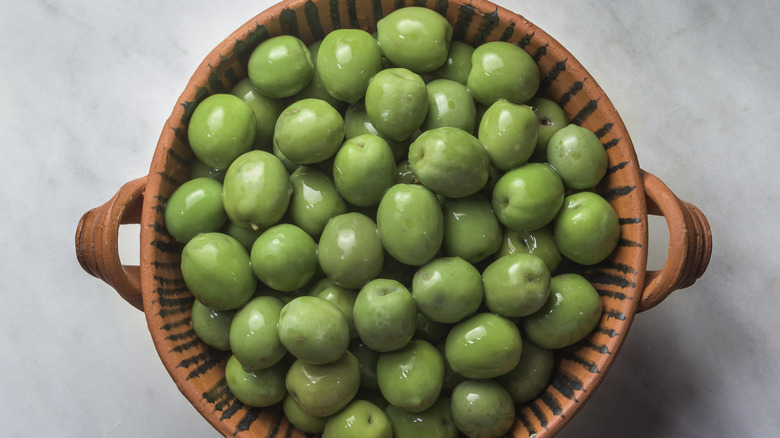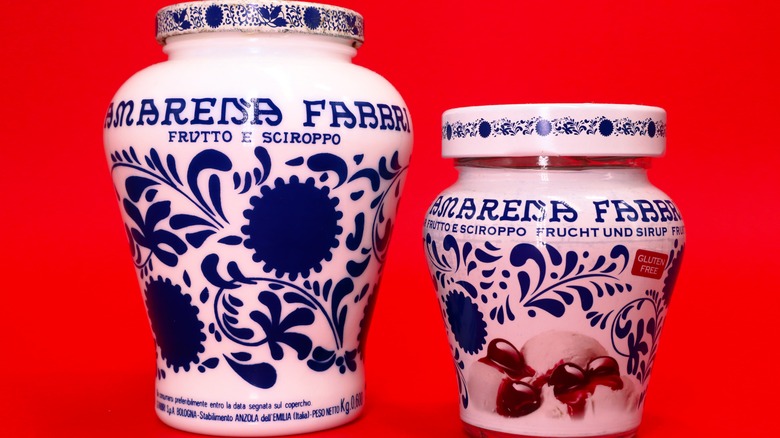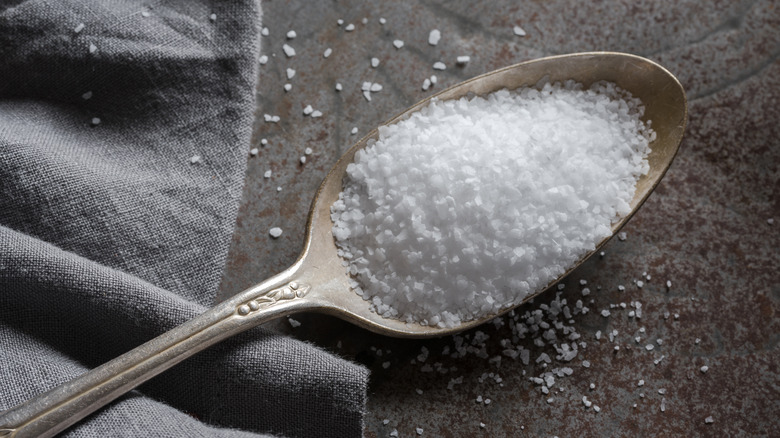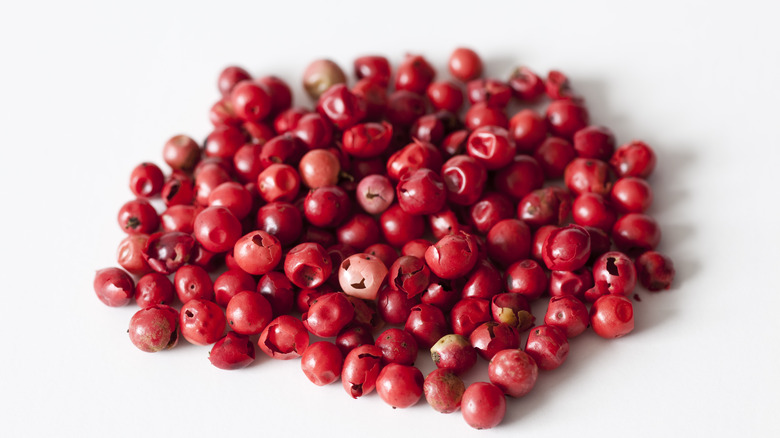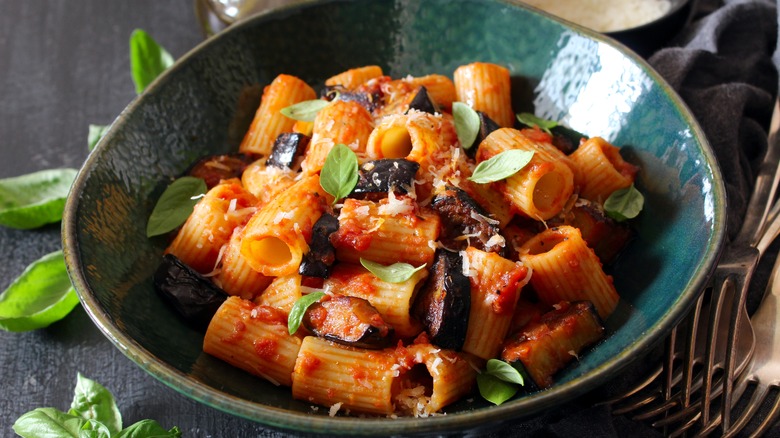15 Ingredients Giada De Laurentiis Always Keeps In The Pantry
In this brave new world of celebrity chefs and culinary luminaries, few things shine as brightly as Giada de Laurentiis and her Italian-inspired cooking. Giada's food philosophy revolves around simplicity, balance, and an unyielding dedication to preserving the authentic flavors of her native Italy while infusing them with contemporary twists that resonate with modern palates. In her culinary kingdom, fresh, high-quality ingredients reign supreme, and each dish is a delicate balance of vibrant colors, enticing aromas, and harmonious tastes.
It may look like all of this comes naturally to Giada, and maybe it does, but she couldn't do it without the support of a well-stocked pantry. One way to gain insight into what Giada keeps in hers, is her site Giadzy, a self-described lifestyle and e-commerce platform where she sells her recommended kitchen products, among other things. Another way to find out what Giada keeps in her pantry is to read through our carefully compiled list, based on Instagram posts and interviews where she decided to bare all, at least in terms of pantry ingredients.
1. Calabrian chili paste
Time and time again, in interviews, on TV, and on social media, Giada De Laurentiis has voiced her love for Calabrian chili paste, specifically the crushed Calabrian chili paste made by Tutto Calabria. And it's easy to see why she loves it so much. As she explains on Giadzy, its flavor is not simply spicy, but also warm and slightly sweet. She uses it to give extra flavor to pasta sauces, stews, and even salad dressings — so pretty much any savory dish she makes.
In particular, Giada uses this staple in her famous Calabrian chili pasta, which is a quick and easy dish to make on a weeknight. Just heat up some canned cherry tomatoes in a skillet with the chili paste, dried oregano, salt, lemon zest, and lemon juice. Simmer, add butter, pour over your penne or rigatoni pasta, and toss to coat evenly. Once you taste this dish, you'll see why you may need to add this ingredient to your pantry, too.
2. Arborio rice
If you've ever watched any of Giada's many shows, you'll know that she makes a whole lot of risotto dishes. And the best rice to use for risotto is, indeed, Arborio rice (or Carnaroli). It is no surprise, then, that she'd keep a generous stock of this ingredient in her pantry.
According to Giadzy, one of Giada's nearest and dearest risotto recipes is her Bitter Rice recipe, named for the first movie starring her grandmother, Italian actress Silvana Mangano. This is Giada's take on a classic Milanese dish, but with a twist, because she wouldn't have it any other way. Typically, risotto alla Milanese is simply made with rice and saffron. But Giada doesn't stop there. In order to make this bitter, as the title says, she adds radicchio, which in addition to offsetting the yellow saffron rice with the deep purple of the leaves, creating an intense visual experience, cuts through the creaminess of the saffron with its bitterness. Lastly, Giada balances it all out with some sweet, dried cranberries. Saffron and radicchio won't keep long in the pantry, but the Arborio rice will be ready and waiting for your next risotto attempt.
3. Dried pasta
No chef could reasonably call themselves an expert in Italian cooking unless they had a boatload of dried pasta sitting in their pantry at all times. In fact, Giada happens to have such a boatload in her pantry. On a virtual tour of her local specialty foods store, that was posted on Instagram in 2019, she explained that pasta was one of the most essential ingredients to have in your pantry. She singled out orecchiette, a small, circular pasta molded in the shape of little ears, which is what orecchiette means in Italian.
To make a classic orecchiette dish, you can follow Giada's recipe for orecchiette pasta with turkey sausage and broccoli rabe. Boil your broccoli rabe before cooking your sausage, breaking it up into pieces as you go, along with garlic and red pepper flakes. Boil the orecchiette, and as soon as they're al dente, strain them and throw in the broccoli rabe and sausage mixture. Easy, healthy, and thoroughly Italian.
4. Jarred tomato sauce
Giada is not above using a ready-made tomato sauce for a quick pasta dish or to spread on a homemade pizza before putting it in the oven. Why should she be? There's absolutely nothing wrong with that if we're talking about a good quality sauce, especially when it comes in many different varieties, including puttanesca and spicy arrabbiata. Her sauces of choice are organic and made by Bio Orto, which she sources directly from Italy and sells on her site, Giadzy.
Aside from a quick pasta dish, you can use these tasty sauces directly on your homemade pizza by following some of our top tips for excellent pizza crust. When you put all your efforts into the crust, as you should, who wants to then start a whole new recipe to take care of the sauce? This way you can have your perfect crust and eat it, too, just by plopping some of this red gold on it before adding your shredded mozzarella.
5. Lemons
As Giada told Bon Appetit in 2018, she buys lemons every week on her regular grocery run, so we think it's safe to say that she has lemons in her pantry at pretty much all times. And this should come as no surprise, since so many of her recipes use lemon as a main ingredient, or call for it to be squeezed on as a finishing touch.
For example, Giada adds a few slices of lemon marinated in sugar to her grilled cheese sandwiches, layering them on top of the mozzarella. And more to the point, is her famous lemon spaghetti, which according to Mashed, is one of the best-selling dishes at Giada, her restaurant in Las Vegas. This recipe calls for a half cup of fresh lemon juice plus a tablespoon of lemon zest, along with olive oil, parmesan, basil, ground black pepper, and of course, spaghetti. The simplicity and deliciousness of this dish will have you buying lemons at the store every week, just like Giada does.
6. Extra virgin olive oil
It's hard to make an Italian meal, or any meal for that matter, without the use of good olive oil. It's required for most sauteing, which is a key step in anything from pasta sauces to soups, and even to salad dressings. Speaking of salad dressings, olive oil is the base of most of these as well, while it can even be used to keep your pasta apart while it's boiling in the pan. And perhaps you didn't know that it can be used for breakfast, too!
In fact, Giada eats olive oil with brown rice for breakfast every day. As she told Delish in 2017, she likes it "swimming in olive oil," so she probably has a lot of it stocked up in her pantry. Because the olive oil is so prominent here, it's important to choose an extra virgin product, or you're not going to get anywhere near the same flavor Giada enjoys every morning. Regular olive oil has a blander, more neutral flavor, and adding it to your rice, or anything else, won't do much to enhance the taste. Extra virgin olive oil is grassier, more peppery, and generally stronger, giving it the ability to actually make plain brown rice taste good.
7. Brown rice
Speaking of brown rice for breakfast, it follows that Giada also has plenty of brown rice in her pantry. But if you tried this breakfast hack and found that it's not your thing, you can use this pantry staple on plenty of other healthful, filling recipes.
You can try this copycat dirty rice recipe from Bojangles, for example. Just brown some sausage with onions, peppers, and garlic, before adding your pre-cooked brown rice with the paprika, cayenne pepper, thyme, salt, and pepper. This makes a great side or a stand-alone dish, even a breakfast one. Just be sure to give yourself enough time to cook the brown rice, bearing in mind that it takes longer than for white rice. And if this is something you've struggled with in the past, consider baking your brown rice instead of cooking it on the stovetop. This recipe, baked for an hour at 375 degrees Fahrenheit, has yielded fully, perfectly cooked brown rice, every time.
8. 00 flour
In a 2023 interview with Tasting Table, Giada recommended using 00 flour when making homemade pasta. There is a good reason for this. This is the finest ground flour money can buy, but more importantly, it's what Italians typically use to make pasta and pizza from scratch. That's because when combined with water, it forms strong gluten, allowing it to become more elastic than doughs yielded by other flours. This is perfect for rolling it out extremely thinly for pasta, or less thinly for pizza. At the same time, it has excellent rising power and can provide those puffy, chewy edges you often see in thick, Neapolitan-style pizza pies.
Try your hand at using this flour by following these key steps in the pasta-making process. Start by preparing a large working space for yourself. If you don't have enough counter space, consider moving to your kitchen table. Then be sure to give yourself enough time. Molding pasta is a delicate process, and rushing it could result in serious errors. Take your time to roll everything out properly before cutting it into linguini or pasta shapes. Or, to save time, use a pasta machine. The result will come out tasting the same as if you'd done everything by hand.
9. Anchovies
A good way to add saltiness and flavor to a dish without actually adding salt, is to use canned anchovies or anchovy paste. This is what Giada often does in her recipes, and you won't necessarily even know it by the taste. That's because the anchovies, whether in paste or filet form, often dissolve during the saute stage.
An example of this phenomenon occurs in the classic puttanesca pasta recipe. Simply saute the anchovies in olive oil with cherry tomatoes and olives, and the small filets will break down by the time the tomatoes are soft. Then add the rest of the ingredients, including just enough water with which to cook the pasta, and cook until all liquid has been absorbed. Good anchovies can also act as the star of the show. For a Spanish tapas take, toast some good quality artisanal bread, smoosh some fresh tomatoes and garlic into the interior, and top with one or two anchovy filets.
10. Canned cherry tomatoes
It's clear from her cooking and from previous pantry selections that Giada is a fan of tomatoes. But in particular, she stocks her pantry with good quality canned cherry tomatoes. As she said in a 2019 Instagram post, cherry tomatoes make "a very sweet, delicious tomato sauce," straying from the typically more acidic creations of larger varieties of tomatoes. As such, she explains, you can put it on all sorts of main ingredients without doing a whole lot to it, including pasta, of course, but also fish, chicken, and more.
See for yourself by using canned cherry tomatoes to make a simple but effective homemade tomato sauce. Simply saute some garlic in olive oil before adding the canned tomatoes along with all their juices. At this point, you will add your seasoning, but be sure to adjust your sugar amounts when using cherry tomatoes, as they are already much sweeter on their own. Boil the mixture, and then simmer for up to three hours. Blend the sauce until smooth, and you're done.
11. Castelvetrano olives
If you've only ever had dark, bitter olives, such as the kalamata variety, set aside all expectations before you try Castelvetranos. They may be of the same species, but their sweet, mild, and buttery flavor make them seem like something entirely different. With their smooth, crisp texture, these green olives are great to enjoy on their own as a pre-dinner snack. But you can also use them in a wide range of recipes that call for olives.
One example are these calamari with lemon, Castelvetrano olives, and bread crumbs. After preparing the bread crumb mixture with stale bread cubes, olive oil, lemon zest, parsley, and black pepper, saute garlic, lemon wedges, and red pepper flakes before adding the squid and white wine. Cook until the calamari is done, and stir in the olives last, so they don't overcook and you can preserve their unique flavor and texture. Sprinkle with the homemade bread crumbs and serve.
12. Preserved cherries
According to a 2019 Instagram post, Giada ate these syrupy cherries growing up and loves them on vanilla ice cream along with the syrup. In particular, she likes Amarena Fabbri's version, also because of the beautiful container in which they come, which Giada cleans out and uses as a flower pot. It's a multipurpose item.
You, too, can put your cherries over your favorite ice cream, but you can also bake with them. Since it's summer and it's too hot to turn the oven on right now, try this raw chocolate cake with Amarena Fabbri cherries. Just chop up a bar or two of fine chocolate and melt it before mixing it in with cocoa powder and heavy cream. Pour your concoction into a pan or mold, and then put in as many cherries as you like, allowing them to slightly float in the batter. Let the cake set in the fridge for at least three hours.
13. Kosher salt
Many professional chefs will steer clear of regular table salt and use coarser varieties, like sea salt or flaky salt. In that vein, Giada De Laurentiis chooses Kosher salt, in part because, as she told CNN earlier this year, "I can feel it in my fingertips how much I'm using." She also mixes it in with oregano and lemon zest to form a ready-made seasoning.
And if you think salt is salt and chefs are just being finicky about it, think again. To summarize: Table salt is mined from underground salt deposits and is extremely fine, and should only be used as a last resort, right before eating, right at the table, hence the name. Kosher salt is coarser and great for seasoning meat. And sea salt comes in uneven flakes and is the least processed of the three, but also the most expensive. Just remember that when using Kosher or sea salt, the larger units mean the salt will dissolve more slowly than the finer table salt, so be sure to wait a few minutes before tasting the product of your seasoning action.
14. Pink peppercorns
Pink peppercorns are not strictly pepper, but berries from a tree in the cashew family. Even so, they have a distinctly peppery flavor, combined with a demeanor that is "floral, warm and pretty all at the same time," as Giada De Laurentiis told Today in 2017.
Use pink peppercorns in your own cooking in both sweet and savory applications. For this pink peppercorn shortbread, cream the butter and sugar together before adding the flour, baking powder, vanilla, salt, and crushed pink peppercorns. Refrigerate for 3 hours and bake at 350 degrees Fahrenheit for 25 minutes. Or simply grate some pink peppercorns over your deviled eggs instead of paprika, giving them that devilish bite without the hellish spice. You can even use them in your cocktails, as per this tart Vermouth cocktail. Dip the rim of your glass in water and then in ground pink peppercorns. Use them again inside your cocktail after muddling them, mixing them with simple syrup, and shaking everything together with ice. These pink peppercorns are really starting to look like a useful ingredient.
15. Rigatoni alla Silana spice kit
Experimenting with spices — the different varieties, combinations, and proportions — can be a lot of fun when you have time on your hands. But we don't always have that luxury. For nights like those, there's the Rigatoni Alla Silana Spice Kit, which combines dried porcini mushrooms, dried tomatoes, eggplant, onions, garlic, parsley, salt, and pepper. And this ready-made bag of goodness is all you need to spruce up a regular, old pasta sauce. You'll just have to rehydrate some of the ingredients in a hot cup of water before adding a can of crushed tomatoes and simmering for about 20 minutes. You'll end up with a typically Calabrian pasta dish packed with umami flavoring.
To make this truly traditional though, and if you do have time after all, you may want to slow-cook some sausage, prosciutto crudo, and guanciale at length, along with the tomatoes. Once everything is cooked through, add the cooked pasta and grated pecorino and caciocavallo cheeses. Either version, with or without meat, is going to be delicious.

